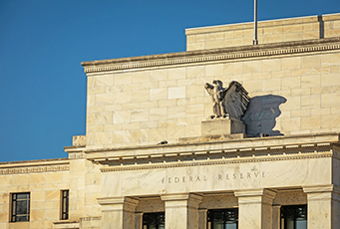The stock market kicked off 2022 with a bang, ushering in the worst performance to start a year since 2016. Despite a strong first trading day of the year in which markets closed at new record highs, the week concluded with all major domestic indices meaningfully negative. What went wrong?
The S&P 500, which measures large-cap U.S. stocks, returned -1.8% on the week, while the Russell 2000 Small-Cap Index fell by an even greater -2.9%.
Two main catalysts were behind this decline: the release of Federal Reserve meeting minutes that laid out plans for the central bank to tighten monetary policy aggressively and a jobs report that showed the unemployment rate falling to 3.9% and wages moving higher. Together these factors indicated that the Fed would take a hawkish approach and quickly end its monetary stimulus programs and raise interest rates.
The swift negative reaction to these events is a good reminder of how much influence the Fed’s actions have on the markets and underscores the importance of equity diversification for long-term investors.
Running Behind the Inflation Curve
Fed Chair Jerome Powell’s recent statement took a more aggressive position to combat the growing risk of inflation than anticipated. After previously dismissing fears of inflation as “transitory,” the Fed shifted its messaging during the final months of 2021 (and began tapering).
Despite this shift, inflation has continued to worsen. The most recent data from December show inflation increased 7% year-over-year, the fastest rate since 1982 and the third straight month over 6%.
With inflation running at 40-year highs and the unemployment rate below the so-called acceptable 4% “natural rate of unemployment,” the Fed finds itself in a situation where it is still providing monetary stimulus in an inflationary environment. This has led some to speculate whether the Fed has kept its foot on the gas pedal for too long and whether it can realistically remove the stimulus without causing a market pullback.
The last time unemployment fell below the 4% threshold in 2018, the Fed had already been raising interest rates for two years and had begun reducing its balance sheet. Now, for the Fed to get out from behind the inflation eight ball, it must act quickly to remove the stimulus that has helped propel the growth in the stock market.
Looking Under the Hood
While the broad market indices were down to start the year, a closer look reveals an even deeper dispersion in performance between different types of stocks.
Historically, the performance of growth stocks (companies with high valuations that are expected to grow their earnings at a faster rate than the market) and value stocks (companies that have fallen out of favor and have relatively low valuations when compared to their long-term potential) are cyclical, with each category taking its turn in the sun.
Growth stocks have greatly outperformed value stocks for much of the past decade, benefiting from the artificially induced, near-zero interest rate environment created by Fed policies. This outperformance has led some to question the benefit of holding value stocks in a portfolio.
However, the recent drawdown to start the year is a prime example of how a diversified portfolio that includes both growth and value stocks can play in limiting volatility. Moreover, suppose the Fed continues with its hawkish monetary policy pivot of less stimulus and higher interest rates. The growth stocks that have benefited the most from the decade-long low-interest-rate environment are most at risk of decline.
And that is what happened during the first week of trading in 2022! While overall, the stock indices were down on the week, growth stocks underperformed value stocks by 5% to 6%. This is a massive performance differential for just one week and a possible indication of how the market leaders may rotate from growth to value as the Fed tightens monetary policy.
Conclusion
The Fed has tremendous influence over the economy and the markets. After years of stimulus, it must navigate an unenviable balancing act of combating inflation without rattling confidence in the markets. While the impact of these decisions is uncertain, a well-diversified investment strategy constructed with your financial advisor can help prepare your portfolio for what is ahead.
About Us | Get the Bedel Blog | More Federal Reserve Articles
Schedule a Consultation
We have helped our clients answer these questions and more. If you want a clear understanding of your financial future, and need help making changes to reach your goals, schedule a consultation and we can get started.
Please remember that past performance may not be indicative of future results. Prior to implementing any investment strategy referenced in this article, either directly or indirectly, please discuss with your investment advisor to determine its applicability. Any corresponding discussion with a Bedel Financial Consulting, Inc. associate pertaining to this article does not serve as personalized investment advice and should not be considered as such.
Recommended Articles
Private Equity and M&A in a Low-Rate World
Deal flow is the stream of business proposals, investment...





